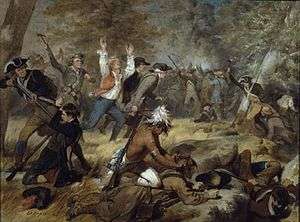Brant's Volunteers
| Brant's Volunteers | |
|---|---|
|
Joseph Brant and his "Volunteers", were British Loyalist associators who, fought for the British, during the American Revolutionary War, took part, in Indian-style, frontier, raids, against Patriot settlements, in the Province of New York. Brant's Volunteers contributed to the large slaughter, of white women, children, and non-combatant families, using unrestricted warfare, in the infamous Cherry Valley Massacre of 1778, which had a similar outcome, to the massacre of settlers, in the Battle of Wyoming, depicted in the painting by Alonzo Chappel, 1858 | |
| Active | 1777-1779 |
| Country |
|
| Allegiance |
|
| Branch | Loyalist associators |
| Type | independent rangers (auxiliary troops) |
| Role | special operations, maneuver warfare, guerrilla warfare, light infantry |
| Size | company |
| Nickname(s) | Joseph Brant's Volunteers |
| Engagements |
|
| Commanders | |
| Notable commanders |
|
Brant's Volunteers also, known as, Joseph Brant's Volunteers were irregular, British Loyalist associators, raised, during the American Revolutionary War, by pro-British, Mohawk chief, Joseph Brant, which fought on the British side, in the Province of New York.
Company formed
The initial size, of Brant's guerrilla company, was approximately one hundred men, consisting of one-fifth (20%), British Loyalist Mohawks and the rest, 80% white, New York, Loyalists. The Loyalists were mostly of English, Scottish, or Irish descent and recruited from the Province of New York. Why the Loyalists would prefer Brant's command is difficult to explain; some refused any other service whatsoever. A simple explanation is that they were wild and undisciplined.
Though Joseph himself received a Captain's commission, in the Six Nations Indian Department, Brant's Volunteers were Loyalist associators; they were unpaid by the British and relied upon plunder (and Joseph's credit) for their compensation. Eventually, Frederick Haldimand authorized provisioning, but no money. Since their unit had no official recognition, many members transferred to Butler's Rangers and the King's Royal Regiment of New York. It grew to at least three hundred men. Later in the war, Brant was able to attract a larger number of Indians to his unit.
Campaigns
Joseph Brant's Volunteers were at the Battle of Oriskany (1777), Battle of Cobleskill, Battle of Minisink, Attack on German Flatts, Raid on Springfield (1778) and at many other battles seeing more action than most other units.
Uniforms
Brant's Volunteers wore yellow lace, on their hats, to be easily identified in battle. Brant's men, at least on occasion, dressed as Indians due to lack of supply and to disguise themselves while raiding their former neighbors:
"Colonel Alden's Report To General, Stark.
Head Quarters, Cherey Valley Aug'st 12th 1778.
Dear General; I have the honour to Informe you that this Morning a Scout of mine Came in who have been Peace Down the Suscohanna taking their rout round by the Butternuts and Returnd by the way of one Tunecliffts who they have, with fourteen or fifteen other Torrys, Brought In Likewise two of Brant's party, who ware Collecting Cattel at the Butternuts for Brant. Ware Clothed and painted Like Indians; with them they have Brought about one hundred head of horn'd Cattel, and horses besides thirty or Forty Sheep then of Brant's Party ware a Scout up to the Butternuts from the Unidlles and ware there Collecting Cattle, Expectlng In two or three Days a Party from Brant's to assist in Careing them Down, but as good Luck would have It we have ben [sic] two quick for them, I have Exeamined them and verily think all of them to be Enemys to this Country, Should much Rather fall Into the hands of Brant then either of them."
Company disbanded and resettled in British Canada
A few of the white, Loyalist members, of the Brant company, were still with the unit, at the end of the war and settled with Joseph Brant and his Mohawks, along the Grand River, Province of Ontario, in British Canada.
Legacy
There are three reenactment groups.
- One, Brant's Volunteers (Oquaga) is based in Brant's home in the Mohawk Valley of NY: www.oquagavolunteers.com
- The second group is associated with the Northwest Territorial Alliance (NWTA) and are based in Indiana.
- A third is based out of Fort Niagara in western NY.
References
- Kelsey, Isabel, Joseph Brant 1743-1807 A Man of Two Worlds, 1984, ISBN 0-8156-0182-4
- Taylor, Alan, The Divided Ground, 2006, ISBN 0-679-45471-3
